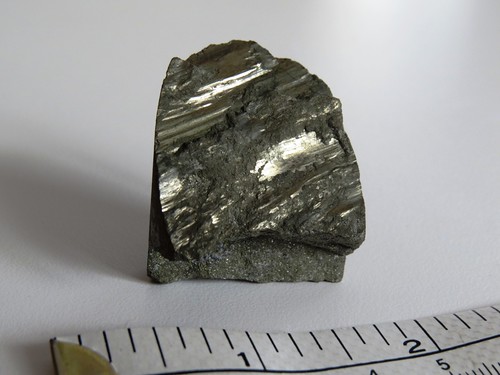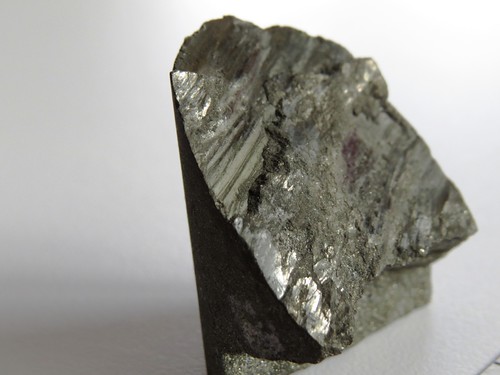Today's rock also comes from Wolverine Mine in the Yukon. This rock is a piece of drill core that I collected it in the fall of 2013 when I was part of an underground exploration and production drill program. Normally you wouldn't be allowed to take *coughstealcouch* drill core, but underground production drilling is different than surface exploration, and you don't need to save and store all of the core drilled.
 |
| This is the surface exploration drill core from the mines' exploration program. There's not as much core as there should've been, but lets not get into that... |
 |
| Each of those core boxes contain about 3-4 m of core. |
Anywho, when I saw the slickensides and slickenlines on this sample, I happily took my rock hammer to the core and pocketed the sample right away. I actually had both sides of the fault, but I gave the other half of it to a geologist friend. What are we looking at and what the heck are slickensides/slickenlines, you ask? Well let me tell ya!
I'm sure you've heard of faults - they often come up when you hear of earthquakes, and there's the ginormous one in California, the San Andreas Fault. Faults are fractures or cracks in the rock where displacement (or movement) occurs, allowing two blocks of rock to slide against each other. The energy released when rocks shift can cause earthquakes if the fault or the displacement is big enough.
This sliding motion can do a lot of really cool things to the surrounding rocks. If the fault breaks the rock fairly cleanly (as opposed to smearing it if the rock is more "plastic" or soft and malleable, which can happen at depth), each side of the fault can become polished as the rock moves against each other. If the rock in question contains a lot of metal, such as in a massive sulphide deposit, this polish can have a mirror like effect!
Now, it's rare that you'll find slickensides without slickenlines. Slickenlines are the grooves (or lines) scratched into the slickenside surface as the rocks move together. But because you often don't find one without the other, we usually just shorten the entire feature as 'slicks'.
 |
| Slickenlines showing the direction of displacement. (source) |
The really cool part of slicklines is that the lines point in the direction of general movement, and other features can actually tell you which side moved what way. This is more difficult to identify in drill core unless you put a lot more work during drilling, but it can give you some idea. Where this is more useful is in outcrops at the surface, where you can get proper azimuth and dip measurements, and is regularly used when discovered to identify fault movement. I saw slicks underground all the time at Wolverine Mine, and always noted the direction of movement on my maps.
And just for some context, here's what the rock looked like where the slicks occurred. As I mentioned somewhere above, the slicks are the massive sulphide deposit, which mostly contained a lot of fine pyrite ("fools gold", an iron-rich metallic mineral with chemical composition FeS2), a little bit of chalcopyrite (the more yellowy copper- and iron-rich mineral, CuFeS2), and some white calcite (CaCO3).
Pretty slick, eh?
:D
Any questions about faults, slicks, or anything else I blathered on about in this post? Is there any type of rock or geological feature you'd like to learn more about? I'm happy to take rock requests!




No questions right now but fascinating, thank you! I live more or less on a fault line (actually my house is at least 100m from the nearest large known fault, but somehow I don't think that's going to matter when it starts to move) but
ReplyDeleteI've never come across this info before. Thanks!
Interesting! I'm from Manitoba Canada, which is located on the most geologically stable place on the planet (literally), so I never experienced earthquakes until I moved to Ontario for my MSc, and then up here. Because of this, I usually write off earthquakes as just a big truck driving past. :)
DeleteI don't know what your fault is like exactly, but not all faults are a hazard. Just because there's a fault, doesn't mean that it's an active fault (meaning that it happened in the distant past or is finished moving in that location), and just because it's active doesn't mean you'll wind up with a huge earthquake someday. Even if there's a lot of movement along the fault throughout the year, if that movement is constant and there's a lot of small earthquakes (or no earthquakes but constant offset), then the energy is released gradually and cannot build up. A big earthquake typically occurs when there's a lot of movement in the fault but the rocks get locked up and can't offset like they're supposed to - energy builds up until it reaches a breaking point (literally) and that built up energy is released.
Sorry, didn't mean to babble so much about earthquakes in this comment! I hope that the discussion on earthquakes doesn't make you nervous about your fault - I'm happy to talk about it further, but I sometimes freak people out unnecessarily when I get excited and babble about rare events. I've always been interested in earthquakes and their causes. :) If you have a chance to go check out the fault site, you might see some slicks if there's decent outcrops!
That was interesting, and understand it more than the knitting schtick ;-)
ReplyDeleteHehehe! I'm so glad you and others seem to be enjoying the rock posts! I do love writing them, but they are a lot more work than babbling about my most favourite obsession. :)
DeleteWell, you asked if we had questions about faults, so here goes. I thought of you last week when I was talking with my daughter about earthquakes happening more frequently in Texas, specifically the Fort Worth area. We were trying to find articles online about if the cause was frakking in the area or if it was bound to happen at that fault line anyway. What are your thoughts on frakking as either a cause of quakes, sinkholes, etc or as a catalyst to these events.
ReplyDelete